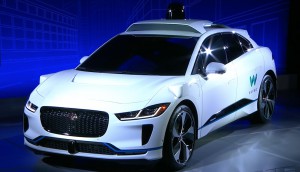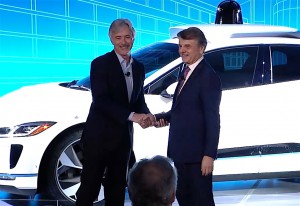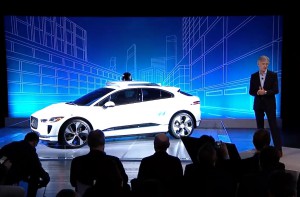Despite a cloud created by this month’s fatal crash of an Uber autonomous vehicle prototype, Waymo today announced it will be full speed ahead as it launches what is expected to become a nationwide driverless ride-sharing service.
During a New York news conference, Waymo CEO John Krafcik revealed the Google spinoff will begin adding as many as 20,000 Jaguar I-Pace SUVs to its fleet, the battery-electric vehicles joining thousands of Chrysler Pacifica Hybrid minivans Waymo had already committed to purchase.
Waymo has spent nearly a decade developing what many experts call the most sophisticated self-driving technology on the road, but Krafcik said his company has now “shifted our focus from research and development to operations and deployment.”
A pilot version of its ride-sharing service has been in operation for more than a year around Phoenix, initially using vehicles with back-up drivers onboard ready to take control in an emergency. But as its confidence has grown, Waymo has begun adding fully driverless vehicles, as well.
(Waymo’s Krafcik joins industry chorus questioning Uber’s autonomous technology. Click Here for the story.)
Experts believe that by eliminating the driver, ride-sharing services will be able to reduce their costs to the point that it will be cheaper to hail a ride than own than operate a private vehicle. A recent study by The Boston Consulting Group estimated as much as 25% of the miles Americans clock on the road will be in driverless ride-share vehicles by 2025.
The Google spinoff recently received permission from the State of Arizona to turn its pilot program into a fully commercial venture. It will initially focus on a 100 square-mile area around Phoenix. But Krafcik made clear it would expand to “more” cities during the expected two-year roll-out of the Jaguar I-Pace acquisition.
The British carmaker’s CEO Ralf Speth was clearly delighted as he joined Krafcik on stage. “We can either shape the future or be shaped by it,” Speth said.
The Jaguar side of JLR has been undergoing some major changes during the last several years – spurred on by its Indian parent, Tata. The best-selling Jaguar vehicle is its first SUV, the F-Pace. It will soon have three utes in its line-up, including the smaller, gas-powered E-Pace and the all-electric I-Pace that is making its formal American debut this week at the New York International Auto Show.
The I-Pace relies on a 90 kilowatt-hour lithium-ion battery that is meant to deliver more than 200 miles per charge. That is a critical feature, said Waymo CEO Krafcik, as it will allow for a long day of operations without needing to go out of service to recharge.
The vehicle is smaller than the Pacifica minivan but is more upscale and should also be able to command a higher premium from customers. Rival Uber already offers its users the ability to call for a more premium vehicle.
(Click Here for more about the Uber fatal crash.)
While Joe Eberhardt, the CEO of JLR’s North American operations said the tie-up with Waymo is a clear endorsement that should give the I-Pace “more credibility,” he also said that the size of the Waymo purchase will stretch the limits of the production capacity the carmaker had set up for the electric SUV. As such, some potential U.S. customers “may have a wait.”
Despite the jubilant tone set by the Jaguar Land Rover and Waymo executives, there was a more somber tone underlying the New York news conference.
On March 18, 49-year-old Elaine Herzberg was killed when she walked off a median onto a Tempe, Arizona, roadway and was struck by an Uber-modified Volvo XC90 SUV, despite the vehicle having an onboard backup operator.
While Tempe police initially suggested the Uber vehicle was not to blame, that has been questioned by a number of observers and a federal safety team is now probing the crash. On Monday, Arizona’s governor, Doug Ducey, suspended Uber’s ability to test its autonomous vehicles on the state’s public roads, calling the crash, “an unquestionable failure.”
Some critics, including California-based Consumer Watchdog, have demanded that all public testing of self-driving vehicles be suspended.
Waymo’s Krafcik, however, asserted that his company has already run 5 million miles of testing on public highways and simulated another 5 billion miles in virtual reality.
(To see more about Waymo’s efforts in Arizona, Click Here.)
“We’ll continue putting the emphasis on safety,” the former Hyundai Motor America CEO said. “It’s the overwhelming, number one goal for everyone at Waymo.”



